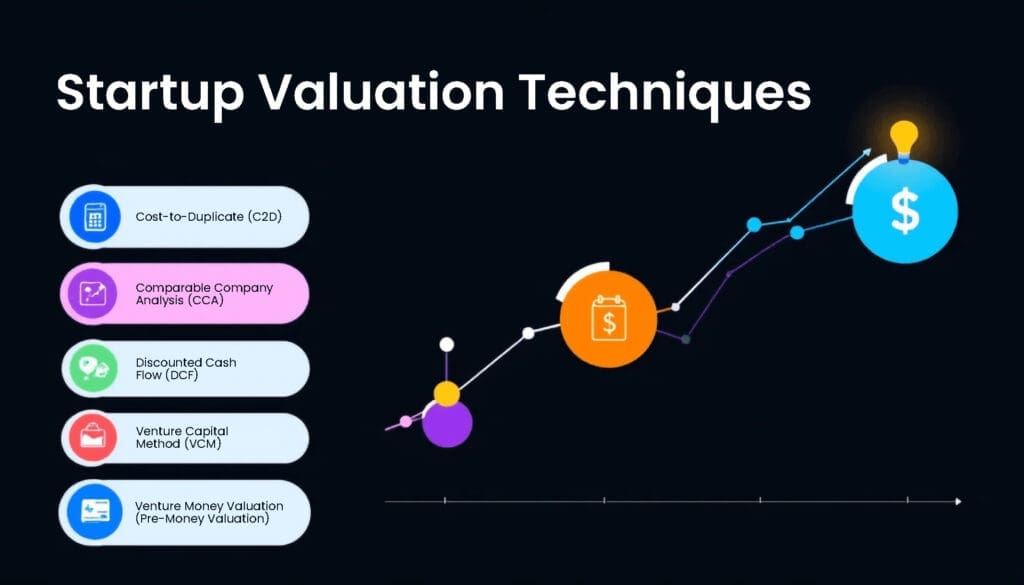Valuing a Startup
Understanding startup valuation is crucial for any founder or investor. Startup valuation determines the financial worth of a startup’s equity at a specific point in time. It influences investment decisions, equity distribution, and the future financial health of the business. This article explores key methods and factors in evaluating a startup’s value, offering insights relevant to early-stage and established startups.
Key Takeaways
- Startup valuation is crucial for decision-making, influencing equity offers to investors, and establishing baseline discussions for funding.
- Key determinants of a startup’s valuation include market potential, product maturity, the founding team’s expertise, and current market conditions.
- Founders should use diverse valuation methods and avoid common pitfalls, such as overestimating market size, to achieve a realistic and accurate startup valuation.
Please see our article on valuing a pre-revenue startup.
Understanding Startup Valuation

Startup valuation is the process of determining the financial value of a startup’s equity at a specific time. This valuation is not just a number but the cornerstone of decision-making for founders and investors. The stakes are high; valuations influence how much equity founders must offer to investors and the future financial health of the startup. They also provide a baseline for discussions about funding and ownership stakes, ensuring that both parties are fairly compensated.
However, valuing a startup is fraught with challenges, especially for early-stage startups. Unlike established companies, startups often lack financial history and market comparables, making it difficult to assess their worth. This uncertainty is compounded by the fact that the valuation process heavily depends on the opinions and sentiments of potential investors. For pre-revenue startups, the complexity increases as there are no revenue metrics to rely on, making the valuation process more of an art than a science.
A well-conducted valuation reflects the startup’s potential for success and aligns with its growth trajectory despite these challenges. It sets realistic expectations for founders and investors, guiding strategic decisions and goal-setting. A startup’s worth is determined by the agreement reached between the company and its investors, making the valuation process a crucial negotiation tool.
Key Factors in Determining a Startup’s Valuation
Determining a startup’s valuation involves a delicate balance of various elements. Investors often examine the total addressable market (TAM) to gauge the startup’s growth potential. A large market size indicates a higher potential for scaling, which can significantly boost the valuation. Additionally, product development stages and the quality of the business model are critical factors. A well-developed product with a clear market fit can lead to higher valuations as it signals readiness for customer adoption.
Market conditions also play a pivotal role in setting valuations. Investors must consider current economic trends and market sentiment to avoid unrealistic expectations. For instance, a startup valued during an economic boom might face adjusted valuations during a downturn. Thus, understanding and aligning with market conditions is essential for realistic valuations.
Moreover, the expertise of the founding team, the competitive environment, and the startup’s strategic positioning within the market are key determinants of its valuation. Investors also scrutinize qualitative factors such as the startup’s team expertise and the competitive landscape. A strong, experienced team can inspire confidence and lead to higher valuations. Conversely, high competition in the market might lower the valuation as it poses a risk to the startup’s growth potential.
Evaluating these diverse factors helps investors arrive at a valuation reflecting the startup’s current and future prospects.
Common Startup Valuation Methods

Valuing a startup is not a one-size-fits-all endeavor. Several methods are used to determine a startup’s valuation, each with its own merits and suitability depending on the startup’s stage and industry. Common methods include the Comparable Transactions Method, Cost-to-Duplicate Approach, Discounted Cash Flow (DCF) Method, and Venture Capital Method.
Each of these methods provides a different lens through which to view a startup’s value, helping investors and founders navigate the complexities of the startup valuation process.
Comparable Transactions Method
The Comparable Transactions Method estimates a startup’s value by analyzing recent acquisitions of similar companies. This method leverages market comparables to provide a benchmark, using data from recent exits in the same sector. For instance, if a fictional shipping startup was acquired for $24 million, another startup with similar user metrics might be valued at around $4 million. This approach ensures that the valuation is grounded in real-world market data, making it reliable.
Improving the accuracy of this method involves considering factors such as the similarity in the sector, location, and potential market size. Adjustments can be made for the stage of business and prevailing market conditions, ensuring that the valuation reflects the startup’s unique circumstances.
Aligning the startup with comparable businesses provides a robust framework for valuation.
Cost-to-Duplicate Approach
The Cost-to-Duplicate Approach is often seen as a starting point for valuing startups because it is based on objective, verifiable historical expense records.
This method estimates a startup’s value by calculating the costs associated with replicating its product, technology, and team if started from scratch today. It considers:
- The fair market value of physical assets
- Research and development costs
- product prototype costs
- Intellectual property and patent costs
While this approach provides a tangible foundation, it may overlook the startup’s future growth potential and intangible assets. Nonetheless, it serves as a helpful baseline, especially for startups with significant investments in technology and infrastructure.
Understanding the replication cost allows stakeholders to gauge the startup’s current valuation and make informed decisions.
Discounted Cash Flow (DCF) Method
The discounted cash flow method is a forward-looking approach that estimates a startup’s value based on its future cash flow potential. This method involves forecasting future cash flows and then discounting them to their present value, providing a clear picture of the startup’s financial health and potential. It is particularly suited for startups with stable revenue models, where future cash flows can be reasonably predicted.
However, the DCF method requires meticulous financial forecasting and a deep understanding of the startup’s business model and market conditions. While it provides a comprehensive view of financial performance, its accuracy hinges on the quality of the projections.
Startups with reliable revenue streams benefit from the DCF method, which emphasizes future value over historical costs.
Venture Capital Method
The Venture Capital (VC) Method estimates a startup’s value based on the expected selling price and desired return on investment (ROI). This method is particularly popular among venture capitalists and involves estimating the exit value and determining the current valuation based on expected returns. For example, if a startup aims for a $20M exit value after receiving a $1M investment, this results in a calculated pre-money valuation of $19M.
The VC method also differentiates between pre-money and post-money valuations. Pre-money valuation indicates a startup’s worth before any financing round, while post-money valuation reflects the company’s value after making an investment. This method helps venture capitalists align their investment decisions with expected outcomes, ensuring their investments have the potential for high returns.
Pre-Revenue Startup Valuation Techniques

Valuing pre-revenue startups presents unique challenges due to the lack of financial metrics. Instead, these valuations often rely on qualitative factors such as the founding team’s experience, market potential, and initial traction. Common methods for pre-revenue valuation include the Scorecard Valuation Method, Berkus Method, and Risk Factor Summation Method.
These approaches provide a framework for estimating the value of startups with little or no revenue, helping entrepreneurs and investors navigate the valuation process.
Please read our article on pre-money vs post-money valuations.
Scorecard Valuation Method
The Scorecard Valuation Method assesses a startup by comparing it to funded startups using specific criteria. The first step is to find the average pre-money valuation of comparable companies in the sector. Then, the startup is evaluated based on factors such as the strength of the management team, the size of the market opportunity, and the product or technology itself.
For example, a strong management team’s impact can account for up to 30% of a startup’s overall valuation, while the size of the market opportunity contributes up to 25%. By multiplying the sum of these weighted factors by the average valuation in the sector, investors can arrive at a comprehensive valuation that reflects the startup’s potential.
This method is favored by investors for its structured approach and focus on key success metrics.
Berkus Method
The Berkus Method is a valuation approach that considers five aspects of a startup, each adding up to $500,000 to the pre-money valuation. Developed by Dave Berkus, this method is particularly useful for tech startups and focuses on metrics such as sound ideas, prototypes, quality management teams, strategic relationships, and product rollout stage.
Each of these five metrics can add up to $500,000, with a cap for pre-revenue valuations at $2 million. For instance, a startup with a strong prototype and a quality management team could receive a valuation of up to $1 million using this method.
The Berkus Method provides a straightforward way to assign value based on critical success factors, making it a popular choice for early-stage tech startups.
Risk Factor Summation Method
The Risk Factor Summation Method adjusts a base valuation by assessing various risks that can either enhance or diminish the startup’s value. This method involves identifying risks such as management risk, market risk, and competitive risk, and assigning a dollar value to each risk factor.
Each identified risk can add or subtract up to $500,000 from the valuation, depending on its potential impact. For instance, a startup with high management risk might see a reduction in its valuation, while one with strong market potential might see an increase.
Summing these adjustments helps investors arrive at a valuation reflecting the startup’s risk profile and overall potential.
The Role of Market Comparables

Market comparables are a powerful tool in startup valuations, providing benchmarks against similar companies to gauge a startup’s worth. This approach involves comparing the startup to similar companies in the same industry and growth stage, ensuring that the valuation is grounded in real-world data. For instance, if similar companies have recently been acquired or have raised funding, their valuations can serve as a reference point.
However, finding direct comparables can be challenging due to the unique characteristics of each startup. Differences in market conditions, product development stages, and competitive environments must be considered in a comparable company analysis.
Despite these challenges, market comparables remain an essential component of the valuation process, providing a reality check and helping to set realistic expectations.
How Investors Use Valuations
Investors use valuations to gain insights into a startup’s growth potential and the amount of equity they can expect in return for their investment. A startup’s valuation affects how much equity founders must offer and influences the future financial health of the startup. For venture capitalists, valuations are crucial in identifying startups with the potential for explosive growth and high-demand opportunities.
Valuations also help investors assess the risks and rewards associated with an investment. By understanding the valuation process, angel investors can determine suitable deals and negotiate better terms. However, obtaining detailed information about deal terms related to comparable startups can be challenging, as this information is often not publicly available.
Moreover, market conditions and economic trends significantly influence valuations and exit predictions. Investors must navigate these uncertainties to make informed investment decisions. As demand for a startup increases, founders can negotiate better terms, ensuring that the valuation aligns with the startup’s growth potential and market opportunity.
Please read our article on SAFE vs convertible notes for startup funding options.
Avoiding Common Valuation Mistakes
Navigating the valuation process is fraught with pitfalls, and avoiding common mistakes is crucial for founders and investors. One significant error is overestimating the market size while underestimating competition. These unrealistic assumptions can lead to inflated valuations unsupported by actual market conditions, raising concerns among potential investors. Similarly, failing to document all assets or neglecting to factor in debts and liabilities can result in significant undervaluation or overvaluation of the business.
Another common mistake is setting too high a valuation too early in the startup’s lifecycle. This can dissuade potential investors due to the lack of supporting data and unmet expectations, which may lead to down rounds or even the closure of operations, as seen in the case of Shyp. Aligning the amount raised with the company’s current valuation is essential to present a realistic and attractive investment opportunity.
Using multiple valuation methods helps gain a comprehensive view of the business’s worth, avoiding common pitfalls. Highlighting past milestones can enhance credibility and positively influence the current valuation. Founders should also be cautious of future funding rounds, as they can dilute ownership and impact valuation.
Mindfulness of these common mistakes ensures a more accurate and realistic valuation process for founders.
Strategies to Boost Your Startup’s Valuation

Boosting your startup’s valuation is an ongoing process that requires strategic planning and execution. A strong and well-defined business plan enhances your startup’s valuation. This plan should clearly outline your business model, market opportunity, and growth strategy. Investors are more likely to value a startup higher if it has a clear path to generating revenue and achieving profitability.
Effectively deploying raised capital within a specified time frame is crucial for increasing valuation. Demonstrating the ability to use investment funds wisely and achieve significant milestones can attract more investor interest and lead to higher valuations. Preparing multiple ambitious funding plans can also position your startup against the competition effectively, increasing its perceived value.
Additionally, emphasizing your startup’s intellectual property and proprietary technology can significantly boost its valuation. Highlighting unique assets that differentiate your startup from competitors can make it more attractive to investors. Focusing on these strategies enhances the startup’s valuation, making it more appealing to investors and securing better terms for future funding rounds.
Please read why a valuation is important to the success of your business.
Summary
Understanding and accurately determining a startup’s valuation is a complex yet essential task for founders seeking to attract investors and secure funding. By exploring various valuation methods, such as the Comparable Transactions Method, Cost-to-Duplicate Approach, Discounted Cash Flow Method, and Venture Capital Method, founders can confidently navigate the valuation process.
Additionally, being aware of common mistakes and implementing strategies to boost valuation can significantly enhance a startup’s appeal to potential investors. With this knowledge, founders can confidently embark on their entrepreneurial journey, setting the stage for future success.
Frequently Asked Questions
What is pre-money valuation?
Pre-money valuation represents a startup’s estimated worth before receiving investment funding, serving as a basis for determining its value before additional capital is injected.
How does the Venture Capital Method work?
The Venture Capital Method estimates a startup’s value by projecting the expected exit price and calculating the current valuation needed to achieve a desired return on investment (ROI). This approach focuses on future selling potential to inform investment decisions.
What are some common mistakes to avoid during the valuation process?
Avoid overestimating market size, underestimating competition, and setting an overly high valuation too early. Additionally, ensure that all assets and liabilities are documented to prevent inaccuracies.
How can I boost my startup’s valuation?
To boost your startup’s valuation, focus on developing a strong business plan, effectively utilizing raised capital, and highlighting your intellectual property and proprietary technology. These steps can significantly enhance investor confidence and perception of value.
What is the Scorecard Valuation Method?
The Scorecard Valuation Method compares a startup to similar funded startups based on key criteria like the management team’s quality and market opportunity. This approach helps establish a more accurate valuation by considering various qualitative factors.
